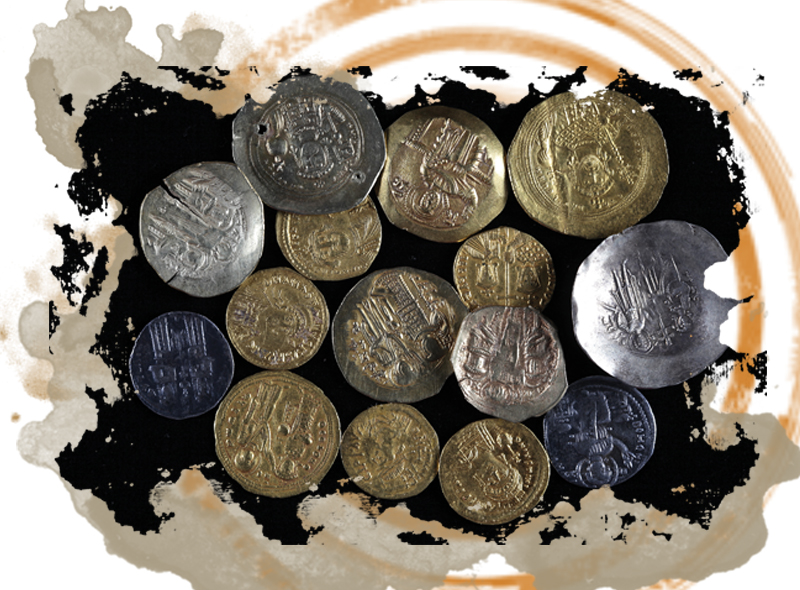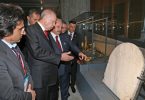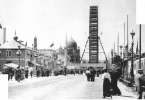First coins in the world was used in China around 900s B.C., as metal replicas of sea shells. First coins with a standard weight and therefore a unit value, were manufactured by Lydians settled in Sardis, Manisa around 600 B.C. These coins called electrum were produced from an alloy of pure gold and silver and world’s first metal coins ended barter era and purchases using currency became more common. Lydians used currency in purchase of goods and services, and commercial system emerged was continued by Persians who later ruled Anatolia.
Gold, silver and bronze coins were manufactured for three centuries in the mints established in the Hellenistic period that began in 334 B.C when Alexander the Great first reached Anatolian lands. Roman Empire conquered most Anatolian cities in the 2nd century B.C., and these cities were authorized to mint Roman coins and bronze coins with observes depicting portraits of Roman Emperors. Roman Empire was divided into two at the end of the 5th century, and Anatolia coin civilization proceeded with Byzantine coins. However Byzantine coins were replaced with Arabic and Islamic coins in centuries. In the 9th century, the only mint in Anatolia was Constantinople mint that invariably manufactured Byzantine coins.
Within the next millennium after the first coin was minted in Anatolia, polytheistic faith and thenChristianity spread in the region and symbols of these religions manifested themselves on coins of the period. Animal, human and plant motifs used in Lydian and Persian coins were accompanied by deities of the period. In the Hellenistic and Roman Empire eras, emperor portraits and symbols of Christianity in Late Roman and Byzantine Empires were included in these motifs.
1071 is a significant year with regard to transformation of Anatolia. Malazgirt War creates an opportunity to establish tens of Turkish beyliks in Anatolia alongside a strong Seljuk Empire. Some pioneering beyliks, particularly Artukoğulları used diverse coins instead of ordinary Islamic coins. There were Islamic inscriptions in Arabic on the coins as well as designs similar to Jesus depictions on Byzantine coins or pictures of warriors on horses or animals. Most coins resembled art objects and are thought to signify the religious toleration of the Islamic faith in Anatolia. From early 12th century, Ilkhanids lost power over Anatolia and coins of the newly founded Anatolian beyliks and even the first Ottoman coins were designed in a way to evoke traditional Ilkhanid coins. However once Ottoman Empire overcame the hardships of establishment period, the world accepted Ottoman Empire as a real Empire with its authentic coin models and designs.
Only a single type of coin minted in the period of Osman I, the founder of Ottoman State, survived to our day. Another administrative reform in period of Orhan of the Ottoman Empire concerned minting. Ottomans minted a coin named “Bid”, the official name of Söğüt district at that period, with a depiction of the first settlement of Ottomans.
Coins are among the key documents which carry the historical, economical, social, technological progress of a society to our day. As a matter of fact, when Ottoman coins are examined, historians come across substantial information not included in the history books. For instance, a copper dirham minted in Sultan Murad II’s period with an emblem of the Kayı clan ended the discussion among historians on origins of the Ottomans.
Islamic states invariably printed excerpts from the Holy Koran on the coins, however it is significant that Ottoman coins bore no religious references from the establishment period. Even examining the sultan titles on the coins provide important clues on power of the state. In the early periods, coins would simply feature names of the sultans and their fathers. As Empire grew stronger, titles such as “Sultan of two lands, Khan of Two Seas Sultan’s Son Sultan” or “Sultan of Greek, Persian and Arabic lands” are observed on the coins. However when the Empire worn by the centuries faced economic hardships, titles were once more simplified.
Coins provide us with accurate information on the fiscal structure of Ottoman State. In the first 150 years of the State, silver currency “Akçe” did not lose any value with regard to weight and carat, and therefore there was no inflation. However in Sultan Mahmud II period, Ottoman state could not even cover war expenditures and reduced the weight and carat of silver coins every three to five years, and was forced to create new currencies.
Following Mehmed the Conqueror’s conquest of Istanbul, first gold coin minted is regarded the sign of Ottoman State becoming an Empire. However within the same years, the weight of Ottoman silver coins were reduced for the first time which led to a janissary uprising. This pointed to an alarming budget crisis in the Empire. In early 17th century, wars Ottoman State waged seriously damaged the economy as coins indicate. Silver coins were too small to use and inscriptions on coins were too faded to be read. Upon entering a peace period after the wars, silver and gold coins each finer than the next were released and this clearly demonstrates that neither party triumphed.
Throughout the rules of 36 Ottoman sultans, 15 thousand distinct coins were minted in gold, silver and copper which provide us with substantial information as reminders of our past, and benefiting from those is a major duty that falls to Turkish museums and collectioners.









Leave a Comment